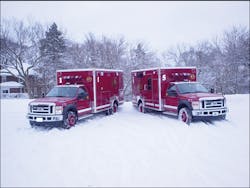Perhaps the most vulnerable part of any apparatus is its undercarriage and suspension.
Frames, springs, tires and related components are critical maintenance areas for apparatus used in severe conditions. It's where the proverbial rubber meets the road, and also the place that is most subjected to all the crud and dirt the elements can sling at them.
Rick Suche is president and owner of Fort Garry Fire Trucks Ltd., an apparatus builder in Winnipeg, Manitoba, building a full line of emergency equipment for all of Canada with some apparatus making their way into the United States and around the world. His trucks are in service in some of the most extreme areas of the planet, including the Arctic.
"People look at our trucks and think we're building tanks," Suche said, noting apparatus endurance for extremes starts with solid apparatus construction. Fort Garry trucks are constructed of 5083 saltwater marine-grade aluminum to stand up to the rigors of what is essentially a constant saltwater spray, Suche said, adding the company also paints all surfaces and seals seams. To maintain the integrity of the body and prevent corrosion, Suche recommended the surfaces be kept cleaned, covered with paint and seams sealed.
Fort Garry also uses grommets and rubber seals where wires intersect with metal frames and around pump intakes and discharges to keep dust and water out and wires from chaffing, Suche said. "The big thing is to keep things clean," he said.
Suche said spring shackles, wheel wells and other places where road grime can accumulate must be cleaned regularly. Some of the trucks built at Fort Garry never see paved roads their entire service lives, so keeping them clean is paramount to longevity, he said.
Suche has been in the fire service for 30 years, serving as a volunteer firefighter and working as the president and owner of Fort Garry, a business established in 1919 and acquired by his father in 1945.
Suche said that because his company knows the trucks they build will be in some of the most extreme environments in world when it comes to corrosive road treatments, the company uses a heavy undercoating. He recommends departments maintain that undercoating with routine oil undercoating once a year, if possible.
Road treatments can be just as bad in Minnesota where General Safety - Rosenbauer America builds apparatus. Steve Reedy is the vice president and general manager of the General Safety division of Rosenbauer America. He's been in the fire service for 38 years and a firefighter and a chief during his career. His secret to preventing corrosion is the use of dielectric grease, a non-conductive silicone grease designed to seal out moisture and preventing corrosion on electrical connections.
"Apparatus in these parts can be driving in what amounts to a constant salt spray," Reedy said. And, while most electrical connections should be routed through bodies and channels, some are out and exposed in the undercarriage and subjected to the elements.
Apparatus are electrical creatures with lots of wires and lots of electrical components that can be damaged by corrosion and, consequently fail. Therefore, care of wiring is critical for apparatus subjected to severe service, Reedy said.
For example, tilt-cab apparatus, equipped with electric motors to raise and lower them, can experience shorts that can cause the cabs to rise while driving, Reedy said. An electrical bridge of salt and crud and be created between the tilt-cab motor and the solenoid that operates it, creating a contact that engages the tilt at any time.
"That can be a dangerous situation," Reedy said, noting that it can be avoided by cleaning the underside of the truck, particularly the motor and connections, which are often located under the trucks in areas that can accumulate crud.
John Marvin is General Safety's service manager and a National Institute for Automotive Service Excellence (ASE) Master Mechanic and an EVT Master as well. He stresses the importance of keeping apparatus clean on the underside.
"You have to keep everything clean, front to back," Marvin said, adding that places like radiator supports and channels are often over looked during cleaning operations. All moving parts under vehicles need to be cleaned, lubricated and exercised routinely to make sure they are operating when needed.
Marvin also said body and cab mounts should be checked and cleaned regularly to make sure they critical joints do not corrode and fail and Reedy said crud can accumulate between the body and the poly tank, another area that can be overlooked when cleaning.
And while crawling around under the apparatus cleaning, Marvin recommends that signs of chafing be observed and checked. Chafing wires can lead to failure and chafing body parts or running gear can mean broken springs suspension problems or a number of potentially dangerous mechanical failures.
In Illinois, the Elgin Fire Department, just outside of Chicago, is serious about keeping apparatus clean. Apparatus are washed routinely and then get a periodic thorough cleaning.
"And every time we bring the apparatus in for preventive maintenance, we pressure wash them," said Covert. "It gets all the crud off them and it helps us find any leaks and keep track of them."
Covert, who is a front-line officer in the department, and has been in the business since 1984, has an administrative assignment to look after the department's fleet. His shop, staffed by skilled and trained firefighters, does a lot of the preventive maintenance on the apparatus and the small engine equipment. Larger repairs and serious maintenance work is shipped out to other shops.
During his years in apparatus maintenance, Covert has learned important lessons in keeping the rigs running when the going gets tough. "Keep them clean and make repairs as soon as you can," Covert said.
At Ferrara Fire Apparatus Inc., in Holden, LA, Paul Christiansen, the company's marketing director and aerial product manager, believes the best thing to fight corrosion is to build it in at the factory. Ferrara uses marine-grade aluminum on plates and 6061-T6 aluminum extrusions, according to Christiansen.
"We use some pretty stout components," Christiansen said. "But to take the really adverse conditions, you have to maintain the apparatus."
One of the particular severe services Ferrara is acutely aware of, being headquartered in Louisiana, is flooding and the havoc it can raise on apparatus, particularly the rear axle. Christiansen said Ferrara puts an extension on the differential air tube to prevent water from contaminating the lubrication in the gear housing.
Water in gear lube can quickly damage the moving parts and contaminated, or even suspected contaminated gear lube should be drained and the components flushed, before fresh lubrication is installed to prevent expensive repairs down the road.
"Anytime you go into flood waters, you should check all the fluid levels and change them if they've got water in them," said Marvin, General Safety's service manager. He added it would serve the apparatus well to hit all the grease Zerks with fresh lube too to drive out any moisture in the joints and fittings.
Rough roads can wreak havoc on apparatus suspension and bodies, never mind the occupants. Christiansen said Ferrara has a special front-end suspension combined with air-ride rear suspension that gives the apparatus a very smooth ride - good to keep the body from twisting too much and beating up the firefighters inside who must endure gravel- or pothole-filled roads.
Some apparatus, like Elgin's ambulances, have four wheel drive to navigate through occasional deep snow the greater Chicago gets. Covert said all-wheel drive does add more components to the apparatus, but they don't require much in the way of additional maintenance and make sense for severe service.
Covert said his department is also considering purchasing all-wheel drive fire apparatus in the future for additional traction and control. "All-wheel drive makes sense in some climates," Covert said.
More Articles and Podcasts From This Series
- Apparatus Maintenance: Severe Conditions Require Extra Apparatus Care
- Severe Service Maintenance: Heating, Cooling and Climate Control
- Severe Service Maintenance: Pump and Body Considerations
- Severe Service Maintenance: Undercarriage Care
- Firehouse Roundtable: Apparatus Maintenance
- Podcast: Rick Suche on Apparatus Maintenance for Severe Service
- Apparatus Makers Recommend Routine Maintenance for Safety
- Following Manufacturers’ Guides Keeps Apparatus in Top Condition
- Finding Qualified Technicians is Key to Apparatus Maintenance
- Firehouse Roundtable Apparatus Maintenance
- Podcast: Apparatus Maintenance: Bill Foster on Apparatus Safety
- Podcast: Apparatus Maintenance: Glenn Davis on Preventative Maintenance Programs

Ed Ballam
Ed Ballam served as associate editor for Firehouse. He is the assistant chief of the Haverhill Corner, N.H. Fire Department, and a National Registered EMT. He is also a Deputy Forest Fire Warden for the New Hampshire Division of Forests and Lands. Professionally, he's been a journalist for over 35 years working for a variety of publications, including employment as managing editor of a national fire service trade journal for more than a decade.








